 Facebook
Facebook
 X
X
 Instagram
Instagram
 TikTok
TikTok
 Youtube
Youtube
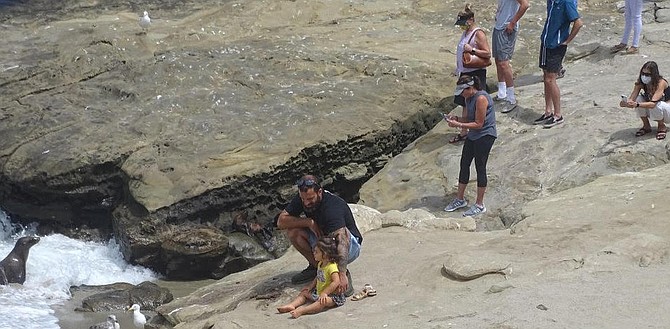
It's sea lion pupping season at La Jolla Cove, right alongside beach re-openings and the human haul out – and social distancing isn't working too well.
At least not between humans and pinnipeds.
Ellen Shively, Seal Society of San Diego volunteer, spent Sunday carrying a sign to help remind people to keep their distance, and witnessing the chaos.

That day she helped rescue a yearling that had seven fish hooks in its mouth. She saw a crowd force three pups off a cliff. The pups couldn't swim out of the crack so the moms kept pushing them up on the rocks, she says.
One mother seal sprang into action. "I actually saw her dive from the top after her pup fell."
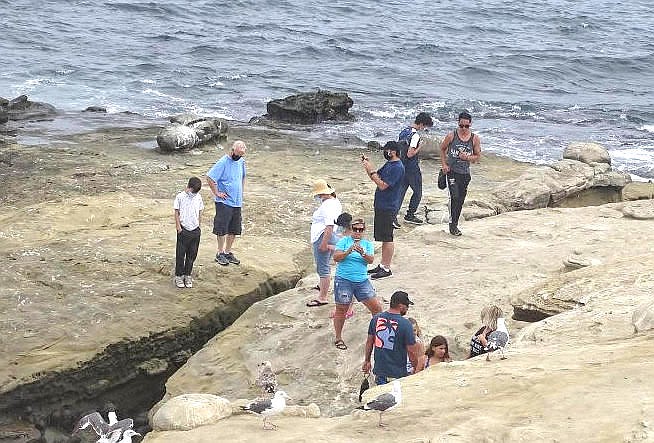
For over two hours, people who drove the pups off the edge watched, laughed and took pictures, she says.
"There were people all over the sand literally chasing the mother sea lions and their pups, throwing sand in the pups' faces and on and on. It was hard to watch."
So what's the right viewing distance from a baby pinniped? Or a 1,000 pound bull?
The answers aren't clear from the signs posted at most entrances to the cove, which only warn against touching animals and staying back, and the Sierra Club Seal Society wants the city of San Diego to step back in.
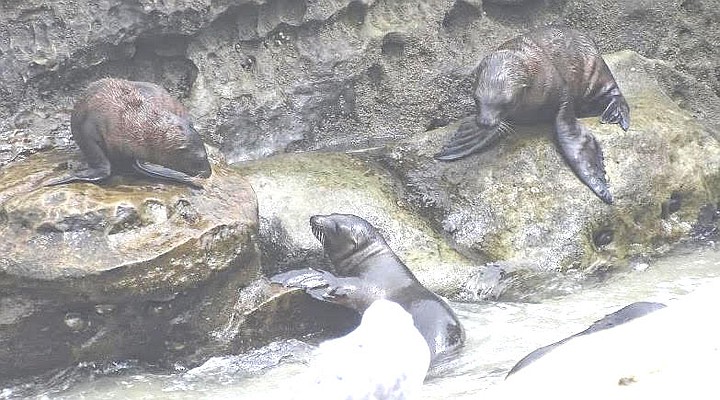
San Diego's Parks and Recreation Department commissioned the Marine Coastal Management Plan-La Jolla in 2017 to address the growing number of human/pinniped encounters, and signs were one recommendation.
The 91-page report tackled the odor issues that prompted an unsuccessful lawsuit by business owners against the city. In the end, the pinnipeds prevailed. Sort of.
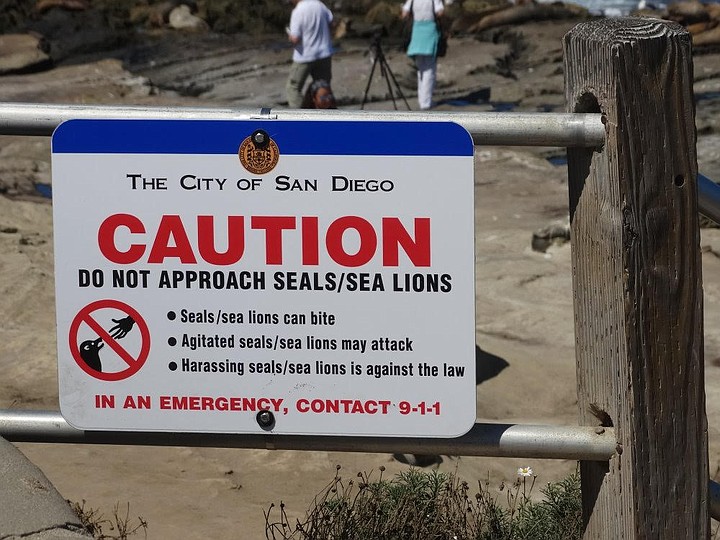
The signs are often ignored, even with splashy wording like "No Selfies with Seals!" People still touch and pet the animals, and block their path to the ocean or beaches, advocates told the San Diego Environmental Committee last week. The situation is "woefully under-managed."
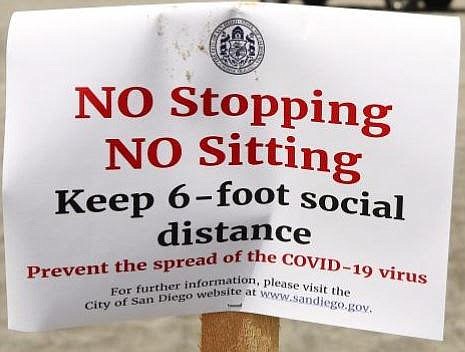
Shively blamed the use of small print, placed far above eye level, and wordy messaging. Some signs are faded. There are few international signs.
And who would know it's pupping season? The signs don't say. When people go down the stairs for a closer view, they may startle the animals, possibly causing the separation of mothers and newborns or raising the risk of a pup drowning.
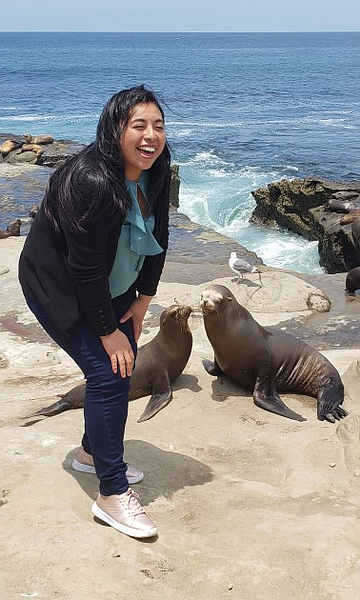
The situation is "dire and dangerous" for both people and animals, they warned, recommending a specific distance be added to the signs, and that a ranger and docent be there daily. Currently, there's only one ranger to monitor La Jolla Cove, La Jolla Point, and Boomer Beach.
Although sea mammals are federally protected from harassment by the Marine Mammal Act – which is enforced by the National Marine Fisheries Service – as well as municipal codes, tickets are rare.
Robyn Davidoff, Sierra Club Seal Society docent suggested that NOAA, the Coastal Commission, and the city of San Diego come up with a reasonable but protective distance guideline.
The National Oceanic and Atmospheric Administration – NOAA Fisheries – recommends a viewing distance of at least 150 feet. Shively says the best viewing spot for sea lions is the sidewalk in front of the Woman’s Bridge Club at La Jolla Point (over 400 feet).
Sierra Club Seal Society draws the line at a minimum of 20 feet.
If it's a selfie, you're way too close.


It's sea lion pupping season at La Jolla Cove, right alongside beach re-openings and the human haul out – and social distancing isn't working too well.
At least not between humans and pinnipeds.
Ellen Shively, Seal Society of San Diego volunteer, spent Sunday carrying a sign to help remind people to keep their distance, and witnessing the chaos.

That day she helped rescue a yearling that had seven fish hooks in its mouth. She saw a crowd force three pups off a cliff. The pups couldn't swim out of the crack so the moms kept pushing them up on the rocks, she says.
One mother seal sprang into action. "I actually saw her dive from the top after her pup fell."

For over two hours, people who drove the pups off the edge watched, laughed and took pictures, she says.
"There were people all over the sand literally chasing the mother sea lions and their pups, throwing sand in the pups' faces and on and on. It was hard to watch."
So what's the right viewing distance from a baby pinniped? Or a 1,000 pound bull?
The answers aren't clear from the signs posted at most entrances to the cove, which only warn against touching animals and staying back, and the Sierra Club Seal Society wants the city of San Diego to step back in.

San Diego's Parks and Recreation Department commissioned the Marine Coastal Management Plan-La Jolla in 2017 to address the growing number of human/pinniped encounters, and signs were one recommendation.
The 91-page report tackled the odor issues that prompted an unsuccessful lawsuit by business owners against the city. In the end, the pinnipeds prevailed. Sort of.

The signs are often ignored, even with splashy wording like "No Selfies with Seals!" People still touch and pet the animals, and block their path to the ocean or beaches, advocates told the San Diego Environmental Committee last week. The situation is "woefully under-managed."

Shively blamed the use of small print, placed far above eye level, and wordy messaging. Some signs are faded. There are few international signs.
And who would know it's pupping season? The signs don't say. When people go down the stairs for a closer view, they may startle the animals, possibly causing the separation of mothers and newborns or raising the risk of a pup drowning.

The situation is "dire and dangerous" for both people and animals, they warned, recommending a specific distance be added to the signs, and that a ranger and docent be there daily. Currently, there's only one ranger to monitor La Jolla Cove, La Jolla Point, and Boomer Beach.
Although sea mammals are federally protected from harassment by the Marine Mammal Act – which is enforced by the National Marine Fisheries Service – as well as municipal codes, tickets are rare.
Robyn Davidoff, Sierra Club Seal Society docent suggested that NOAA, the Coastal Commission, and the city of San Diego come up with a reasonable but protective distance guideline.
The National Oceanic and Atmospheric Administration – NOAA Fisheries – recommends a viewing distance of at least 150 feet. Shively says the best viewing spot for sea lions is the sidewalk in front of the Woman’s Bridge Club at La Jolla Point (over 400 feet).
Sierra Club Seal Society draws the line at a minimum of 20 feet.
If it's a selfie, you're way too close.
Comments